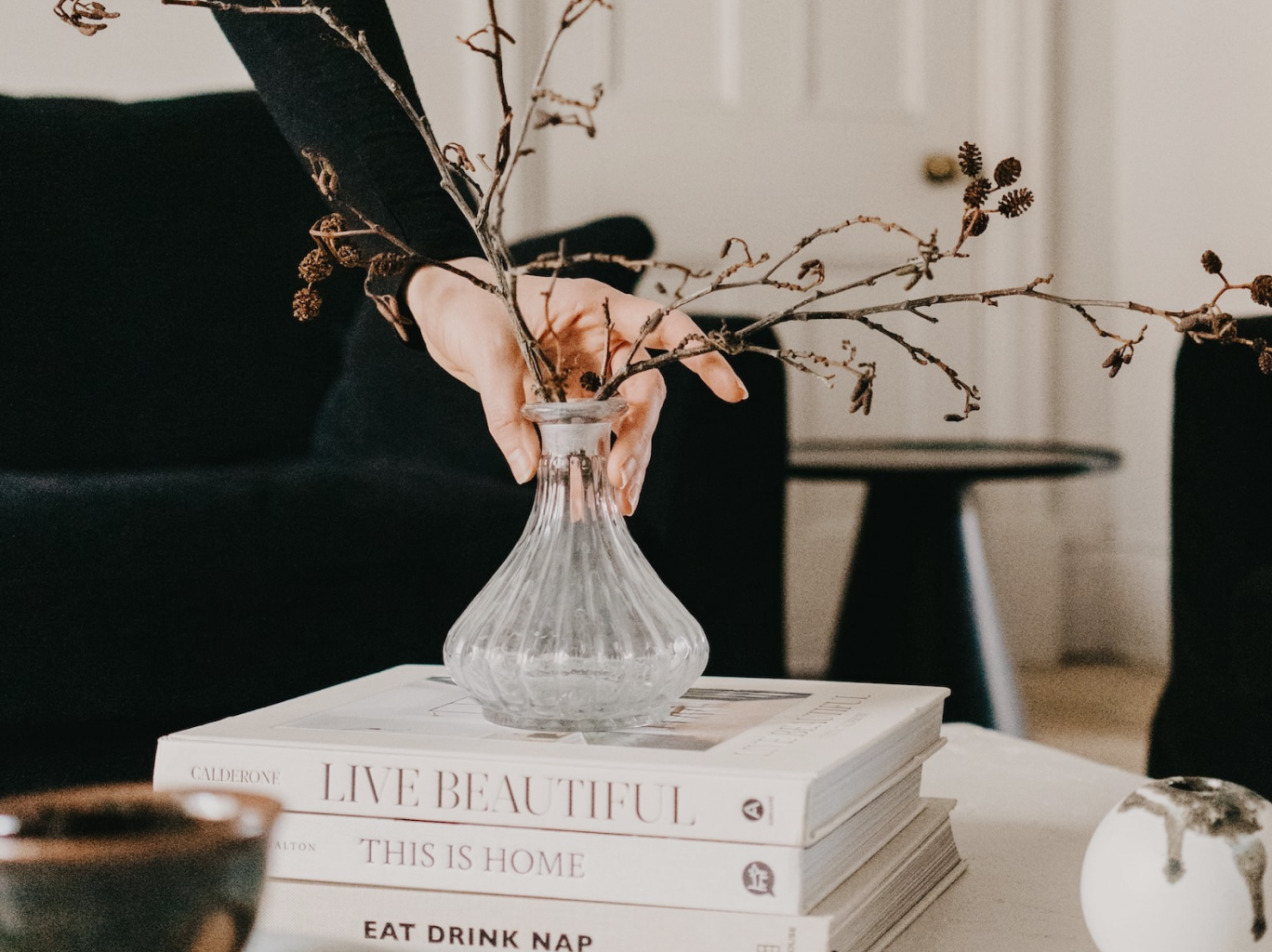If you’ve ever pinned together a dream board for your home, you’ve probably heard of feng shui. As one of the many ancient practices from China that have been popularized in the West, feng shui has garnered respect — and misinterpretation — over the years. When done correctly, the centuries-old art of arrangement infuses harmony and balance into buildings, objects, and spaces, but when done incorrectly, it’s believed to have energetic consequences we’d all like to avoid.
To learn how to leverage feng shui to support productivity, connection, and focus in our lives, we’ve consulted with the teachings of etiquette master Sara Jane Ho. The Chinese educator has a decade-long career in being intentional and poised in all facets of life, and feng shui is a personal and professional passion she lives by. Here are a few of her top tips for integrating mindfulness into your home and beyond.
An Introduction to Feng Shui
To begin, let’s take a look at the words. “Feng means ‘wind,’ and shui means ‘water,’” Sara shared on the AsianBossGirl podcast, elaborating on the practice’s origins. “Its roots are in early Taoism — a Chinese spiritual thought.”
If you don’t know, Taoism is the ancient Chinese philosophy that teaches harmony with the universe. Philosopher Lao Tzu is credited for a collection of Taoist thoughts and teachings in the book Tao Te Ching that highlights many of the beliefs and sayings that are the foundation of feng shui’s principles on balance and energy. (This energy is referred to as Ch’i or qi, but more on that later.)
“Rather than thinking of feng shui as a limited practice for interior design, look at it as a guide for internal energy and alignment in all facets of life.” – Nancy Twine
As a Hong Kong native, Sara comes from a rich cultural background embedded in feng shui. From her boarding school decisions as a high schooler to ending a four-year relationship, feng shui has impacted many of her most important life decisions.
“Hong Kong Chinese believe in feng shui because it’s a big, southern Chinese practice,” Sara explains, adding that feng shui extends far beyond the home. Rather than thinking of feng shui as a limited practice for interior design, look at it as a guide for internal energy and alignment in all facets of life.
But if you’re not fully ready to jump into a committed relationship with feng shui, here are a few of Sara’s best practices for anyone looking to strengthen their vitality.
Three Things to Know About Feng Shui
As you start your feng shui journey, Sara says three things are essential to understand:
1. Ba-Zi
If you’re working with a feng shui master, they may ask about your ba-Zi. In Chinese astrology, ba-Zi (or Bazi) is known as the Eight Characters or Four Pillars of Destiny. (Year, month, day, and hour pillars that unlock some hidden truths about you.)
Astrology aficionados may be familiar with a birth or natal chart, which breaks down hyper-specific aspects of a person’s life, personality, and future based on the day and hour of their birth. Ba-Zi is similar and is a custom guide for your energy boosters and blocks, which supports mapping your feng shui plan.
2. Ch’i
As mentioned in the introduction, Ch’i or qi is energy, not like lightning or caffeine, but a literal life force. In Asian cultures, your Ch’i keeps you alive, and feng shui is how to tend to it. What you do in your life impacts how much Ch’i is stored and released. Feng shui serves as a way to measure if you are optimizing your Ch’i or depleting it.
For Sara, a common Ch’i example is how big a space is. A single person living in a large home can weaken the Ch’i. Too big a space means Ch’i is spread out instead of concentrated, diluting its power. On the opposing end, hosting a housewarming with loved ones increases Ch’i as each individual brings their life force into a home to re-energize the space.
3. Yin and yang
Not to be confused with romanticized Western interpretations, yin and yang are balances within all things. Yin represents femininity, darkness, softness, and the moon. Yang, on the other hand, holds the masculine, aggressiveness, brightness, and the sun.
Yin appears slow, cool, wet, and dark in your home. (Yin may be a quiet, moody reading corner.) Its counterpart, yang, is fast-moving, loud, active, and brightly lit. (Imagine the buzz of a New York stock exchange trading floor.)
General Best Practices of Feng Shui
Sara’s go-to checklist for feng shui in any space can be surmised in six quick tips:
1. South-facing is the most auspicious house direction
This position is coveted in many homes because of its unobstructed view. Light pours into the space, and you can see straight ahead, which implies power and command. This dates back to ancient China when emperors would sit in the north and face the south when ruling the country. Plus, an open view represents your outlook on the future. (Meaning your goals are less likely to be blocked.)
2. Square rooms and homes are clearer layouts for Ch’i to pass through
Other shapes aren’t considered ideal for energy flow. Awkward corners are like knives that cut through Ch’i.
3. Your living room is one of the most important in the home
This area would ideally be south-facing. (East-facing would also suffice.) Since living rooms experience a lot of energetic movement, from socializing to entry and re-entries, it’s essential to be mindful of feng shui to keep it balanced.
Feng Shui Best Practices For Every Room in Your Home
To get the most out of your space, Sara calls attention to a few main areas of the home with tips on nurturing Ch’i in every space.
1. Living room
If you can’t be south-facing, incorporate elements to bring balance. Use shades or more water elements, including aquariums, fountains, or humidifiers, and the color black (not blue or teal) to represent water. This will help counter west-facing living rooms’ excess heat and light.
In common spaces like living rooms, it’s preferable not to have sharp corners. Rounded tables are more inviting for shared areas. Another tip? Avoid having dark, creepy, or violent artwork. These images can call in negativity. Sara also suggests being careful with animals and people in artwork. Family portraits are fine, but depending on your ba-Zi, conflicting energies can be channeled through artwork and potentially siphon your Ch’i.
Love repurposing or thrifting items for your home? Sara says to be sure to cleanse and clean used items. This step will remove the energy of previous owners to keep your Ch’i free from harm.
Generally, fake and dried flowers that look brown and lifeless bring more yin energy into spaces. This is believed to cause imbalances in darker energy and even welcome death into spaces. Too much yin can manifest as depression, struggle, and sadness.
2. Kitchen
The kitchen represents prosperity, so it’s best to have a contained kitchen to protect your Ch’i. (Sorry open-concept lovers!)
Sara also says to keep knives and sharp objects stored out of sight. (Tucking things away in drawers and cabinets.)
Speaking of sharp objects, Sara says pointing razor edges — like the blades of knives and rectangular tables/counters — towards yourself or within the house can cause some energetic damage. (Try to point sharp tools towards a window or outdoor space when possible.)
3. Bedroom
The biggest no-no for Sara is a mirror facing the bed. She says this is especially true if you’re in a relationship. (Mirrored beds can mean a third party will disrupt your connection.)
Never rest with your feet pointing in the direction of the door. In ancient China, when a person died, they were arranged on the bed with their feet facing the doorway for removal. You’re vulnerable in your sleep energetically, so keep Ch’i high by rotating the bed or repositioning it away from the door altogether.
Ideally, keep the bedroom electronic-free. Electronics have more yang energy. (Which is why it’s recommended you power down before bed.) The bedroom, however, should be more yin to promote rest. (Sara admits that she has a television in her own room, but still…)
Lead with yin, which means dark. (It might be time to retire the all-white minimalist look.) Sara recommends minimizing brightness in the bedroom. Choose calm or darker colors to promote serenity and quiet instead of vibrant hues that wake up the space (and keep you awake.)
4. Office or Workspace
The number one tip for offices and workspaces? Have a commanding position. Sara says your back should be solid and protected. (A wall behind you while you face the door is best.) This also translates to the dining area, where the host should face the door from the head of the table.
Your desk should have sharp corners in spaces where business and negotiations occur. Unlike your living area, your office is where you boss up. Sharp corners are your boundaries and positioning.
When thinking about materials, wood furniture is better than glass for groundedness in money-making areas. (Save the glass for the ceilings you’re shattering.)
In the modern age, structural transparency in workspaces is all the rage. (Think of tech companies where the CEO’s office sits in clear view of employees.) For Sara, leaders should be behind a desk that covers their bottom half. Ancient leaders would sit behind tables with hidden legs to reinforce authority and lessen their vulnerability to attacks. This lack of exposure shielded their bodies as they tucked away precious items or weapons.
Final Notes on Feng Shui
These small tweaks can revive any space if you’re new, returning, or curious about the practice. Don’t feel limited if you don’t own a property or can only tackle one room at a time. For Sara, doing something is better than nothing.
Live in a studio or efficiency space? When Sara found herself in a New York studio, she created balance with creative divisions. Her top tip? Embrace multi-use furniture to divide up sections of your floor plan. Use a bookcase, sofa, or rug to draw lines and contain Ch’i where necessary.
Channel your inner Marie Kondo and declutter as much as possible. Ch’i is all about circulation, and clutter creates energy blocks. Get rid of what you don’t use, need, or remember even owning. You can also declutter by creating flow when laying out your furniture. Avoid an interior design that makes you feel trapped.
Last but not least, follow trends in moderation. If you want to do a minimalist design, be sure it’s not so bare that you feel unsupported or unseen. Find yourself and your balance, regardless of the style. And like most things in life, trust your gut. If it doesn’t feel right, simply don’t do it.
What area of your home could use a little feng shui? Drop your feng shui questions or success stories in the comments!




